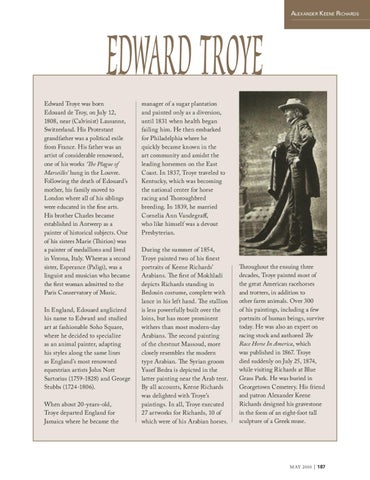ALEXANDER KEENE RICHARDS
EDWARD TROYE Edward Troye was born Edouard de Troy, on July 12, 1808, near (Calvinist) Lausanne, Switzerland. His Protestant grandfather was a political exile from France. His father was an artist of considerable renowned, one of his works ‘The Plague of Marseilles’ hung in the Louvre. Following the death of Edouard’s mother, his family moved to London where all of his siblings were educated in the fine arts. His brother Charles became established in Antwerp as a painter of historical subjects. One of his sisters Marie (Th irion) was a painter of medallions and lived in Verona, Italy. Whereas a second sister, Esperance (Paligi), was a linguist and musician who became the first woman admitted to the Paris Conservatory of Music. In England, Edouard anglicized his name to Edward and studied art at fashionable Soho Square, where he decided to specialize as an animal painter, adapting his styles along the same lines as England’s most renowned equestrian artists John Nott Sartorius (1759-1828) and George Stubbs (1724-1806). When about 20-years-old, Troye departed England for Jamaica where he became the
manager of a sugar plantation and painted only as a diversion, until 1831 when health began failing him. He then embarked for Philadelphia where he quickly became known in the art community and amidst the leading horsemen on the East Coast. In 1837, Troye traveled to Kentucky, which was becoming the national center for horse racing and Thoroughbred breeding. In 1839, he married Cornelia Ann Vandegraff, who like himself was a devout Presbyterian. During the summer of 1854, Troye painted two of his fi nest portraits of Keene Richards’ Arabians. The fi rst of Mokhladi depicts Richards standing in Bedouin costume, complete with lance in his left hand. The stallion is less powerfully built over the loins, but has more prominent withers than most modern-day Arabians. The second painting of the chestnut Massoud, more closely resembles the modern type Arabian. The Syrian groom Yusef Bedra is depicted in the latter painting near the Arab tent. By all accounts, Keene Richards was delighted with Troye’s paintings. In all, Troye executed 27 artworks for Richards, 10 of which were of his Arabian horses.
Throughout the ensuing three decades, Troye painted most of the great American racehorses and trotters, in addition to other farm animals. Over 300 of his paintings, including a few portraits of human beings, survive today. He was also an expert on racing stock and authored The Race Horse In America, which was published in 1867. Troye died suddenly on July 25, 1874, while visiting Richards at Blue Grass Park. He was buried in Georgetown Cemetery. His friend and patron Alexander Keene Richards designed his gravestone in the form of an eight-foot tall sculpture of a Greek muse.
M AY 2010 | 187
